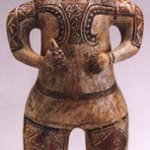Galo Polychrome Standing Male, 500 CE - 1000 CE
Terracotta
28.5
PF.3569
This standing male figure comes from the Guanacaste-Nicoya polychrome tradition, the galo polychrome style. Its mirror-bright burnished surfaces are technically unsurpassed by any Pre-Columbian pottery, and yellows, reds, oranges, creams,...
This standing male figure comes from the Guanacaste-Nicoya polychrome tradition, the galo polychrome style. Its mirror-bright burnished surfaces are technically unsurpassed by any Pre-Columbian pottery, and yellows, reds, oranges, creams, maroons, and blacks of the polychrome decorations are impressively vivid. Among such sculptures are the full human figures with elaborate representations of tattoos or body paint. Such brilliant polychrome tradition represent an important social dimension; when the northern trade network that brought jade, slate-backed pyrite mirrors, foreign ceramics, and other luxury goods, the Nicoyans responded by producing their own special purpose pottery. Inspired by northern models, it also incorporated local and southern elements, forming a dazzling hybrid style that was traded around Central America and southern Meso-America in the centuries to come. Elaborately decorated with colors and patterns, this large sculpted male stands with a strong physical presence. A fine example of galo polychrome figures, he provides a wealth of ethnographic detail because of the realistic style. His headdress, earspools, and body painting or tattooing are all vividly shown. Two large cross-shaped forms enhance the cheeks and a symbolic pattern decorates the chest. The body painting is intricately rendered in a symmetrical manner, further accentuating the refined sculptural quality. With both of his hands gently placed on his belly, he appears as if he is contemplating something, deeply in his thoughts. Although the exact significance of the figure is esoteric, it does not cease to fascinate us.



